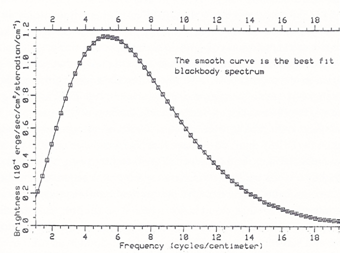- 1610: Galileo
- 1676: Ole Rømer
- 1687: Isaac Newton
- 1781: William Herschel
- 1838: Friedrich Bessel
- 1861: William and Margaret Huggins
- 1912: Henrietta Leavitt
- 1917 Einstein
- 1920: Harlow Shapley
- 1929 Edwin Hubble
- 1948: Ralph Alpher
- 1949: Fred Hoyle
- 1963: Maarten Schmidt
- 1964: Arno Penzias and Robert Wilson
- 1978: Vera Rubin and Kent Ford
- 1989: Margaret Geller and John Huchra
- 1992: John Mather and George Smoot
- 1995: Robert Williams
- 1998: Saul Perlmutter and Brian Schmidt
- 2010: Wendy Freedman
COBE Finds Evidence for the Afterglow of the Big Bang
All warm objects give off light, and the color of the light indicates the temperature of the object. For example, a glowing metal filament in an incandescent bulb appears to be yellow. However a spectroscope reveals that not all of the light from the filament is yellow. The glowing wire gives off light at a range of frequencies called a “black body curve.” Our eye averages the light from all of these different colors and sees “yellow.” Similarly a glowing piece of charcoal in a barbeque appears to be red, but actually gives off light at a range of frequencies, including infrared, which we cannot see but we can feel as “heat.”
Penzias and Wilson observed the light from the Big Bang at just one frequency, so they could not confirm the full characteristic curve from the 3° background. In the decades since their observation cosmologists attempted to measure the background at other frequencies, but it was very difficult since much of the light was blocked by Earth’s atmosphere. Since COBE was above the atmosphere it succeeded in measuring light across many frequencies. The graph below shows the results.
 The boxes in the graph indicate COBE’s observations. The size of each box shows the estimated error of each observation. The solid line shows the expected results if the microwaves were indeed the afterglow of the Big Bang. The findings matched the prediction perfectly.
The boxes in the graph indicate COBE’s observations. The size of each box shows the estimated error of each observation. The solid line shows the expected results if the microwaves were indeed the afterglow of the Big Bang. The findings matched the prediction perfectly.
At last the cosmic microwave background was confirmed to be coming from the afterglow of the Big Bang. When this graph was shown to a large group of astronomers, they stood and applauded.
The notion that images taken by the COBE and WMAP surveys can be considered “baby pictures” of the universe is not simply a metaphor. The theory of the evolution of the universe states that these tiny variations in temperature led directly to the development of stars and galaxies as the universe expanded. The excellent statistical relationship between the images from COBE and WMAP and the three-dimensional galaxy maps that are being constructed with the help of the Sloan Digital Sky Survey shows that gravity alone, acting on the initial material of the Big Bang, is capable of forming the structures of the universe.